
January 31, 2009
Homeschool
Seeker
Volume #001
January 2009

In
this issue
- Introduction
- Sponsor February special
- Website updates
- Math Basics Mini Lapbook
- Tip of the month
- Sponsor ad
- Homeschool Picture of the month
- Homeschool Question/Answer
- Wishlist
- Closing Comments
Introduction
Welcome to the
premier issue of The Homeschool Seeker. I hope you enjoy the newsletter
as well as the mini lapbook. This month's feature topic is basic
math.

Website
Updates
I only have one
major
update on the website that is coming this month to report. I will be
taking down
the used books for sale section as I feel it really isn't helping
anyone. Instead I will be replacing that with reviews of websites
that sell either new or used products that will be helpful for
homeschoolers. There will be a form to make suggestions for either
products or websites that you might want reviewed.
Feature
Mini Lapbook
This month's
feature mini lapbook is on Basic
Math. Here's how I created this mini
lapbook.
1. Gather supplies
Supplies you will need for this mini lapbook:
- 3 brown paper lunch bag
- hole punch
- yarn or string or other material to finish
construction of lapbook
- markers, coloring crayons, pencils,
pens
Optional Supplies:
- Stencils
- Art supplies
- stickers
- glitter
- glue
- scissors
- Math
book or SparkCharts. I have the SparkCharts and they are a handy
reference and highlight the important facts. Of course, a basic math
book at your child's level will also work but it will take a little
longer perhaps to gather the information.
If you are interested in the SparkCharts you can get them at bookstores
or here is a link to Amazon.com.
2. Once you have all your supplies, fold the 3 paper bags in 1/2 and
hole punch the edges.
For more pictures on how this will look and basic assembly you can
visit Mini Lapbooks
3. Begin by decorating cover. I would recommend at least labeling it
with "Math Basics"
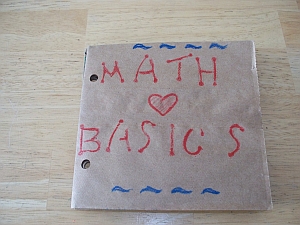
4. Choose concepts (The concepts I chose are highlighted in yellow)
From the SparkCharts
- Natural Numbers
- Whole Numbers
- Integers
- Rational Numbers
- Real Numbers
- Imaginary Numbers
- Complex Numbers
- Digits vs. Numbers
- Place Value
- Rounding
- Addition/Subtraction
- Multiplication/Division
- Order
of Operations
- Inequalities and Signs
- Properties of Addition and Multiplication
- Multiplication by nines
- Factoring
- Factor
Trees
- Divisibility
Rules
- Greatest Common Factor
- Least Common Multiple
- Multiplication Table
- Fractions
- Proper and Improper Fractions and Mixed Numbers
- Equivalent Fractions
- Comparing Fractions
- Adding Fractions
- Subtracting Fractions
- Multiplying Fractions
- Reciprocals
- Dividing Fractions
- Mixed Numbers
- Interpreting Decimals
- Comparing Decimals
- Adding and subtracting Decimals
- Multiplying Decimals
- Dividing Decimals
- Geometric
shapes
- Graphs
- Powers and Roots
- Measurement
- Percent
- Converting Between Decimals and Fractions
- Positive and Negative Numbers
- Scientific Notation
- Time
- Metric System
- Symmetry
- Math Symbols
5. Delegate pages for each concept
With the concepts I chose:
- Cover Page
- Addition, Subtraction
- Multiplication, Division
- Factor Tree
- Symmetry
- Symbols (Wanted to make a testing flap up so
needed to make sure this was on a page with a flap.)
- Symbols
- Order of Operations
- Rules of Divisibility
- Fractions
- Fractions
- Geometric Shapes
6. Label pages
7. Add information
- Addition, Subtraction
Depending
on your child's age and ability determine if they need to practice just
one set of facts or perhaps on 2 digit or 3 digit subtraction/addition.
Add a couple of examples of each. If you do a set of facts consider
using a flap up page to make a testing flap up.
On the top of the flap write the practice equation. Underneath the flap
write in the answer.
- Multiplication, Division
Same
as above. Another option would be to make the whole mini lapbook a fact
book. The idea would be to devote 1 page to 1 equation such as 1 X 8 or
2 X 8

- Factor Tree
My suggestion here would be to do a
couple of examples on a practice sheet and then give your child a 3
digit number and have them factor it out. If correct they get to put it
in the book as an example and decorate the page.
- Symmetry
One
idea to demonstrate symmetry would be to have your child find
symmetrical images in magazines and cut and paste them into the lapbook
or they could also draw some funny but symmetrical images. Let them be
creative.
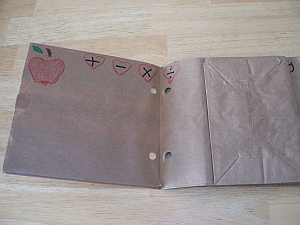
- Symbols
I devoted 2 pages to symbols
for my daughter because I wanted her to really understand that certain
terms correlate with certain mathematical operations. So I had her make
a flap test of the symbols.
Example: (Of) in a word equation means to multiply
- Symbols
The second symbol page I had her devote to the symbols of inequality...
greater than, less than, etc.
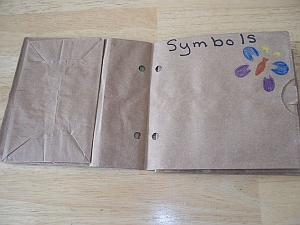
- Order of Operations
For
this page I had her copy the order and decorate the page. My main focus
here is that she learn the order. By reviewing this lapbook
often
and applying it in her lessons I am confident this will not be a
problem.
- Rules of Divisibility
Again these rules are
extremely useful when your child gets into higher levels of math...so
introduce the rules, have them write and illustrate the rules to begin
with and then review often.
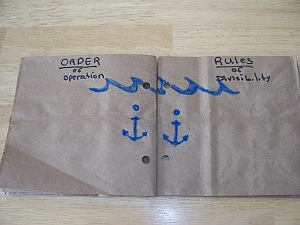
- Fractions
As you can see
from the list a whole mini lapbook could be devoted to fractions. In my
example picture I drew a fish as an example of how someone with younger
children can start to introduce fractions. I tried to make it like a
little game. How many yellow stripes does the fish have? How many total
stripes? Part of the whole concept.
- Fractions
On the
second example page, I wanted to show how one could start applying math
concepts to other subjects. In this case, the study of art and
composition.
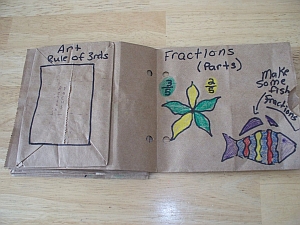
- Geometric Shapes
The final page I devoted
to preschoolers. I made a collage of pictures composed of simple shapes
using stencils. With a young child I would then sit down and ask them
to count the different types of shapes.
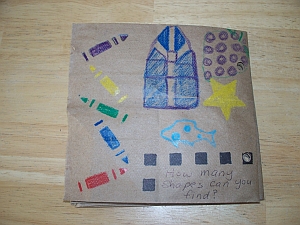
8. Review information
The
idea is to adapt the information to the level of your child. A Math
Basic book for a preschooler would be much more basic than a book for
an eight year old child.
Again, I suggest using your child's
regular math book to get an idea of some topics. Pick topics that were
or are difficult for your child or that you feel are important for them
to review. This would be a great end of the semester/book/year project.
During the break, if they just reviewed the main concepts once a day,
the material from the previous book would be more likely retained.
9. Add finishing details and final assembly
Decorate the mini lapbook with art crafts and supplies. Assemble by
sewing or attaching the bags together.
Tip of
the Month
Math Tip of the
Month: Use a timer. Make it fun. Play math games. For basic math
practice one game is to pick a favorite 1 digit number, for
example 8. Then anytime you see a bigger number have your child try to
figure out a way to come up with 8.
Pick #:8
Pick another #: 17
Ask how can they use the digits in 17 to get to 8. 1+7 =8
Sponsor ad
*************

*************
Homeschool
Picture of the Month

This picture is
a tribute to our snow school day. We transformed a field with images.
This is mine...I love snow and I love snow days.
If you would like to send a picture to be considered for use in The
Homeschool Seeker there are several places on the website where you can
submit the image.
The best places to submit images for the newsletter would be at
Kid's Create
Just please add title HOMESCHOOL SEEKER PICTURE so that I know
it is not a Kid's creation submission. Thanks.
Homeschool
Question/Answer
Question: How do I
keep my children focused on their math problems. They get easily
distracted and if I walk away for even a few seconds I come back to
find them staring out the window.
Answer:Actually
there are several things you can try to help your child focus.
******************************************************************
Use a
Timer
I like to use a timer. Set the timer for just a little bit less than
how fast you want them to finish 5 problems.
For example I want my son to finish 5 problems in 6 minutes.
So I set the timer for 5 minutes.
Now, make a game
or challenge your child to beat the timer.
******************************************************************
Do
they understand how to do the problems?
Also, make sure they understand
the problem or how to do the problem.
It may be that your child is stuck and rather than ask for
help...daydreams or fiddles.
If you discover this is the problem, take a deep breath and explain the
steps again on how to solve the problem. Have them then work through
similar types of problems until you are confident they know how to do
the steps. Then go back to the original problem and watch only as they
work out the problem.
It is important they learn to do the questions without prompting. If
you find yourself prompting them...stop. (I say that in the most loving
of ways)
Let them figure it out. If you find that you are prompting them -start
over with explaining the steps by using an alternative method. Try
doing the problem in a more hands-on or visual manner.
******************************************************************
Is the material too easy?
Another thing to watch out for is that the work is not challenging
them. If this is the case, you have several options. Go on with the
next lesson, get a different curriculum, move up a level (caution:
remember textbooks have many review lessons in the beginning and if
this is happening here -don't move up a level...just reinforce weak
areas and go to a more challenging material section.)
******************************************************************
Observation
Careful observation of your child as he/she does Math can help
determine how you should try to get them to focus.
One of my children I discovered has severe allergies. This can also be
an attributing factor but this problem can be treated.
Another one of my children is easily distracted by well...just about
everything. The timer method works best for her but it works better if
she is racing me. I usually have to knit a row or something in the same
amount of time she is working on her problems.
Homeschool
Wishlist
I really want
to make this a newsletter you enjoy reading. So if you have ideas,
comments or suggestions please visit Homeschool Wishlist
Closing
Comments
I hope you
enjoyed this issue of The Homeschool Seeker. Until next time, happy
homeschooling!
JulieD
January 2009

In
this issue
- Introduction
- Sponsor February special
- Website updates
- Math Basics Mini Lapbook
- Tip of the month
- Sponsor ad
- Homeschool Picture of the month
- Homeschool Question/Answer
- Wishlist
- Closing Comments
Introduction
Welcome to the
premier issue of The Homeschool Seeker. I hope you enjoy the newsletter
as well as the mini lapbook. This month's feature topic is basic
math.

Website Updates
I only have one
major
update on the website that is coming this month to report. I will be
taking down
the used books for sale section as I feel it really isn't helping
anyone. Instead I will be replacing that with reviews of websites
that sell either new or used products that will be helpful for
homeschoolers. There will be a form to make suggestions for either
products or websites that you might want reviewed.
Feature Mini Lapbook
This month's
feature mini lapbook is on Basic
Math. Here's how I created this mini
lapbook.
1. Gather supplies
Supplies you will need for this mini lapbook:
Optional Supplies:
2. Once you have all your supplies, fold the 3 paper bags in 1/2 and hole punch the edges.
For more pictures on how this will look and basic assembly you can visit Mini Lapbooks
3. Begin by decorating cover. I would recommend at least labeling it with "Math Basics"
4. Choose concepts (The concepts I chose are highlighted in yellow)
From the SparkCharts
5. Delegate pages for each concept
With the concepts I chose:
6. Label pages
7. Add information
On the top of the flap write the practice equation. Underneath the flap write in the answer.
Example: (Of) in a word equation means to multiply
8. Review information
The idea is to adapt the information to the level of your child. A Math Basic book for a preschooler would be much more basic than a book for an eight year old child.
Again, I suggest using your child's regular math book to get an idea of some topics. Pick topics that were or are difficult for your child or that you feel are important for them to review. This would be a great end of the semester/book/year project. During the break, if they just reviewed the main concepts once a day, the material from the previous book would be more likely retained.
9. Add finishing details and final assembly
Decorate the mini lapbook with art crafts and supplies. Assemble by sewing or attaching the bags together.
1. Gather supplies
Supplies you will need for this mini lapbook:
- 3 brown paper lunch bag
- hole punch
- yarn or string or other material to finish construction of lapbook
- markers, coloring crayons, pencils,
pens
Optional Supplies:
- Stencils
- Art supplies
- stickers
- glitter
- glue
- scissors
- Math book or SparkCharts. I have the SparkCharts and they are a handy reference and highlight the important facts. Of course, a basic math book at your child's level will also work but it will take a little longer perhaps to gather the information.
2. Once you have all your supplies, fold the 3 paper bags in 1/2 and hole punch the edges.
For more pictures on how this will look and basic assembly you can visit Mini Lapbooks
3. Begin by decorating cover. I would recommend at least labeling it with "Math Basics"

4. Choose concepts (The concepts I chose are highlighted in yellow)
From the SparkCharts
- Natural Numbers
- Whole Numbers
- Integers
- Rational Numbers
- Real Numbers
- Imaginary Numbers
- Complex Numbers
- Digits vs. Numbers
- Place Value
- Rounding
- Addition/Subtraction
- Multiplication/Division
- Order of Operations
- Inequalities and Signs
- Properties of Addition and Multiplication
- Multiplication by nines
- Factoring
- Factor Trees
- Divisibility Rules
- Greatest Common Factor
- Least Common Multiple
- Multiplication Table
- Fractions
- Proper and Improper Fractions and Mixed Numbers
- Equivalent Fractions
- Comparing Fractions
- Adding Fractions
- Subtracting Fractions
- Multiplying Fractions
- Reciprocals
- Dividing Fractions
- Mixed Numbers
- Interpreting Decimals
- Comparing Decimals
- Adding and subtracting Decimals
- Multiplying Decimals
- Dividing Decimals
- Geometric shapes
- Graphs
- Powers and Roots
- Measurement
- Percent
- Converting Between Decimals and Fractions
- Positive and Negative Numbers
- Scientific Notation
- Time
- Metric System
- Symmetry
- Math Symbols
5. Delegate pages for each concept
With the concepts I chose:
- Cover Page
- Addition, Subtraction
- Multiplication, Division
- Factor Tree
- Symmetry
- Symbols (Wanted to make a testing flap up so needed to make sure this was on a page with a flap.)
- Symbols
- Order of Operations
- Rules of Divisibility
- Fractions
- Fractions
- Geometric Shapes
6. Label pages
7. Add information
- Addition, Subtraction
On the top of the flap write the practice equation. Underneath the flap write in the answer.
- Multiplication, Division

- Factor Tree
- Symmetry

- Symbols
Example: (Of) in a word equation means to multiply
- Symbols

- Order of Operations
- Rules of Divisibility

- Fractions
- Fractions

- Geometric Shapes

8. Review information
The idea is to adapt the information to the level of your child. A Math Basic book for a preschooler would be much more basic than a book for an eight year old child.
Again, I suggest using your child's regular math book to get an idea of some topics. Pick topics that were or are difficult for your child or that you feel are important for them to review. This would be a great end of the semester/book/year project. During the break, if they just reviewed the main concepts once a day, the material from the previous book would be more likely retained.
9. Add finishing details and final assembly
Decorate the mini lapbook with art crafts and supplies. Assemble by sewing or attaching the bags together.
Tip of the Month
Math Tip of the
Month: Use a timer. Make it fun. Play math games. For basic math
practice one game is to pick a favorite 1 digit number, for
example 8. Then anytime you see a bigger number have your child try to
figure out a way to come up with 8.
Pick #:8
Pick another #: 17
Ask how can they use the digits in 17 to get to 8. 1+7 =8
Pick #:8
Pick another #: 17
Ask how can they use the digits in 17 to get to 8. 1+7 =8
Sponsor ad
*************
*************
Homeschool Picture of the Month

This picture is
a tribute to our snow school day. We transformed a field with images.
This is mine...I love snow and I love snow days.
If you would like to send a picture to be considered for use in The Homeschool Seeker there are several places on the website where you can submit the image.
The best places to submit images for the newsletter would be at
Kid's Create
Just please add title HOMESCHOOL SEEKER PICTURE so that I know it is not a Kid's creation submission. Thanks.
If you would like to send a picture to be considered for use in The Homeschool Seeker there are several places on the website where you can submit the image.
The best places to submit images for the newsletter would be at
Kid's Create
Just please add title HOMESCHOOL SEEKER PICTURE so that I know it is not a Kid's creation submission. Thanks.
Homeschool Question/Answer
Question: How do I
keep my children focused on their math problems. They get easily
distracted and if I walk away for even a few seconds I come back to
find them staring out the window.
Answer:Actually there are several things you can try to help your child focus.
******************************************************************
I like to use a timer. Set the timer for just a little bit less than how fast you want them to finish 5 problems.
For example I want my son to finish 5 problems in 6 minutes. So I set the timer for 5 minutes.
Now, make a game or challenge your child to beat the timer.
******************************************************************
Also, make sure they understand the problem or how to do the problem.
It may be that your child is stuck and rather than ask for help...daydreams or fiddles.
If you discover this is the problem, take a deep breath and explain the steps again on how to solve the problem. Have them then work through similar types of problems until you are confident they know how to do the steps. Then go back to the original problem and watch only as they work out the problem.
It is important they learn to do the questions without prompting. If you find yourself prompting them...stop. (I say that in the most loving of ways)
Let them figure it out. If you find that you are prompting them -start over with explaining the steps by using an alternative method. Try doing the problem in a more hands-on or visual manner.
******************************************************************
Another thing to watch out for is that the work is not challenging them. If this is the case, you have several options. Go on with the next lesson, get a different curriculum, move up a level (caution: remember textbooks have many review lessons in the beginning and if this is happening here -don't move up a level...just reinforce weak areas and go to a more challenging material section.)
******************************************************************
Careful observation of your child as he/she does Math can help determine how you should try to get them to focus.
One of my children I discovered has severe allergies. This can also be an attributing factor but this problem can be treated.
Another one of my children is easily distracted by well...just about everything. The timer method works best for her but it works better if she is racing me. I usually have to knit a row or something in the same amount of time she is working on her problems.
Answer:Actually there are several things you can try to help your child focus.
******************************************************************
Use a
Timer
I like to use a timer. Set the timer for just a little bit less than how fast you want them to finish 5 problems.
For example I want my son to finish 5 problems in 6 minutes. So I set the timer for 5 minutes.
Now, make a game or challenge your child to beat the timer.
******************************************************************
Do
they understand how to do the problems?
Also, make sure they understand the problem or how to do the problem.
It may be that your child is stuck and rather than ask for help...daydreams or fiddles.
If you discover this is the problem, take a deep breath and explain the steps again on how to solve the problem. Have them then work through similar types of problems until you are confident they know how to do the steps. Then go back to the original problem and watch only as they work out the problem.
It is important they learn to do the questions without prompting. If you find yourself prompting them...stop. (I say that in the most loving of ways)
Let them figure it out. If you find that you are prompting them -start over with explaining the steps by using an alternative method. Try doing the problem in a more hands-on or visual manner.
******************************************************************
Is the material too easy?
Another thing to watch out for is that the work is not challenging them. If this is the case, you have several options. Go on with the next lesson, get a different curriculum, move up a level (caution: remember textbooks have many review lessons in the beginning and if this is happening here -don't move up a level...just reinforce weak areas and go to a more challenging material section.)
******************************************************************
Observation
Careful observation of your child as he/she does Math can help determine how you should try to get them to focus.
One of my children I discovered has severe allergies. This can also be an attributing factor but this problem can be treated.
Another one of my children is easily distracted by well...just about everything. The timer method works best for her but it works better if she is racing me. I usually have to knit a row or something in the same amount of time she is working on her problems.
Homeschool Wishlist
I really want
to make this a newsletter you enjoy reading. So if you have ideas,
comments or suggestions please visit Homeschool Wishlist
Closing Comments
I hope you
enjoyed this issue of The Homeschool Seeker. Until next time, happy
homeschooling!
JulieD
JulieD